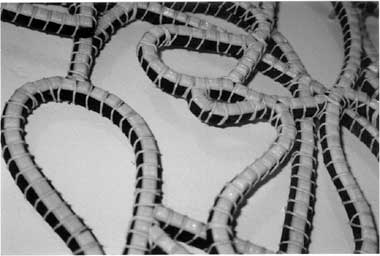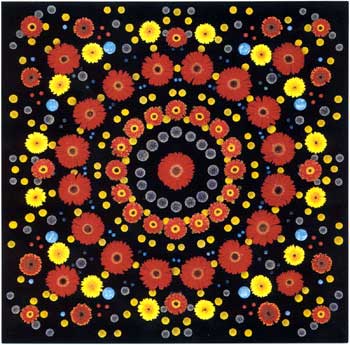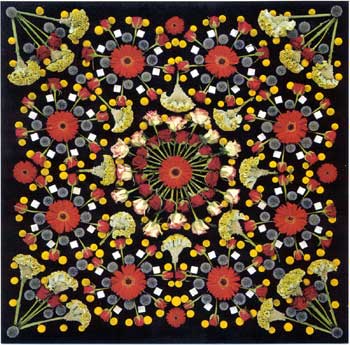Sibylle Guipaud describes the work of one Belfast-based artist.
English artist Michael Brennand-Wood draws with fabrics. At the age of fifty he makes handcraft in an expressive way, learning from the work of Rauschenberg, Tapiès and Cristo. Originally from Manchester, Brennand-Wood gained his Fine Art degree there in 1975. Two years later, he completed his M.A. in Birmingham. “When I went to Art school, I thought ‘I’m going to be a painter or a sculptor’ and I got interested in using cloth as well, but in an expressive way," explains Brennand-Wood. 1 He finally hit what was, for him, the right track: “I didn’t want to make dresses or to make furnishings…I would hopefully make art out of cloth."
It was an old family story. “My grand-mother on my mother’s side was a weaver in a cotton mill…North of England used to be a big weaving-cotton area…when I was a little boy I used to play a lot with fabric."
Using fabric in Fine Art is an area that has not been widely developed. Brennand-Wood has at times experienced a sort of isolation in the art world. “It kind of pushes you into an area very much in your own. You are between painting, sculpture, textiles…you are in this other world." But far from being afraid of uncharted territory, Brennand-Wood is happy with breaking new ground: “What is exciting about this is that it is really new, you can do different things…I like that."
Twenty years ago Brennand-Wood came to Belfast for the first time as a lecturer at the University of Ulster. Since then, he has kept on coming back. He is currently researcher in historical textiles there.
Last year, he was the selector of the first handcraft exhibition at the Ormeau Baths Gallery, in Belfast. Brennand-Wood exhibited several of his own works as well. His research into historical textiles obviously provides the thread of his inspiration. Maid of sugar, made of spice is an example of an original technique, using the process of inlaying fabric on a painted-wood ground. “I cut greys or holes into the wood and then I insert the fabric into that surface." The pattern is inspired by pieces of Italian sixteenth-century lace, but Brennand-Wood diverts this from its original and expected use. Traditionally women made lace on a small and delicate scale. “It is an obvious symbol of femininity…As a man who works in textiles what I was really trying to do was to reclaim lace fabric for men…change people’s appreciation of something they normally see as very small fragments." In order to change the connotation of the lace pattern, Brennand-Wood blows it up. It is a big work, 3.5m wide by 1.2m high. An interior and essentially domesticated construct thus becomes an architectural piece whose shape is reminiscent of stained glass.
The series of work called The fragrance and the flavour of the truth shows the variety of the artist’s research. The process is innovative. “Lines are cut from wood then it’s covered in white mosaics and then it’s banded around with the thread. It won’t be the same twice." It is like a Japanese calligraphy. Pieces of writing fascinate the artist: “letter forms, script forms, how a language is formed really."
The composition does not follow a particular scheme. It is almost the opposite of Maid of sugar, made of spice because of the lack of background, as if it has been dissolved. As a consequence, “every time you move it you change the composition."
Brennand-Wood’s creativity travels. He has been participating in exhibitions in many locations, from Australia to Norway, though his work is particularly appreciated in Japan. He first went there in 1998. “Japanese contemporary textiles are very good and I think they basically like my work."
But Brennand-Wood is also very keen on working in the UK. In 2002 he created a series of thirty-five works entitled Stars underfoot within the framework of the Year of the Artist organised in the UK. A partnership was set up between Brennand-Wood, a florist and a photographer. The aim of the project was to question the relationship between flowers and textiles. “All through the history of textiles, they have had flowers…I didn’t like it very much…I use flowers not as an image but as a material, in a way making the pattern in real flowers rather than in an allusion to flowers." That is why Brennand-Wood adds other materials like glass or pieces of marble. The result is a “floral installation using thousand of flowers on my studio floor." It’s an ambitious production with a standard scale of 1.20m by 1.20m. For the artist, making a photographic record is crucial because, of course, the flowers die.
Brennand-Wood is currently involved in a new work for the A&E service of the Royal Aberdeen Children’s Hospital in Scotland. He is working on the idea of a sand-moving circle similar to an hourglass. “I try to be positive about the idea of waiting in a hospital." Flowers or sand, Brennand-Wood surely knows how to play with the elements.
Sibylle Guipaud, a native of Toulouse with a Masters in Cultural History, is pursuing a career in journalism.



